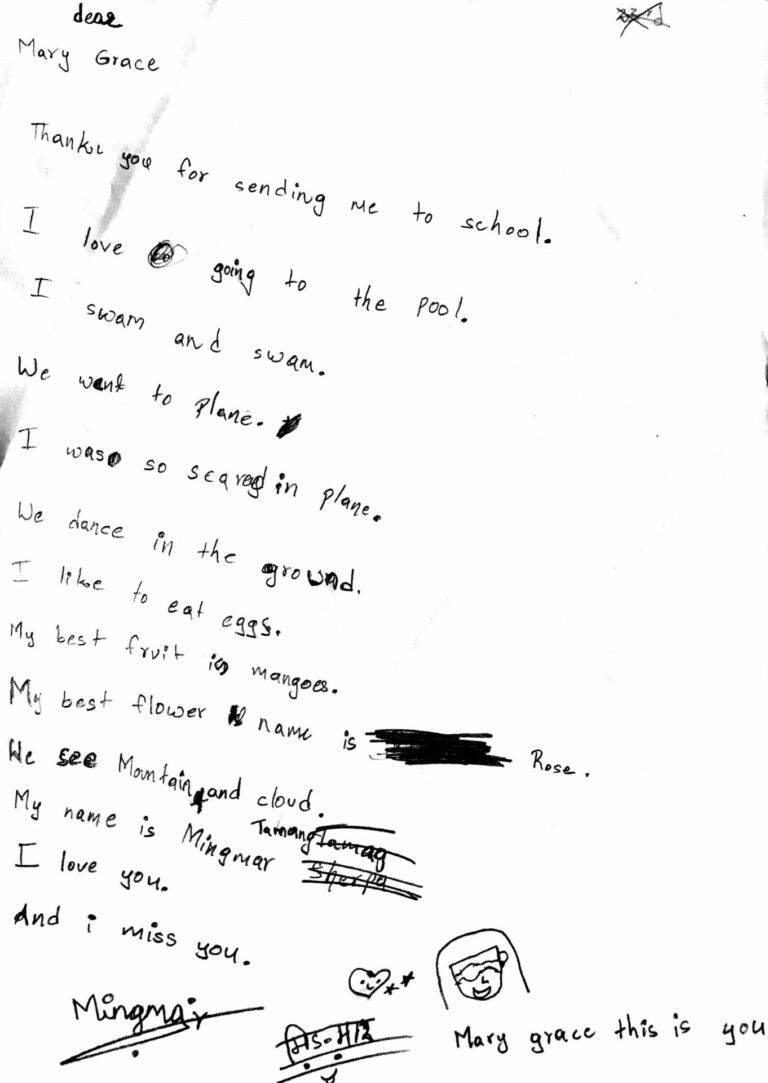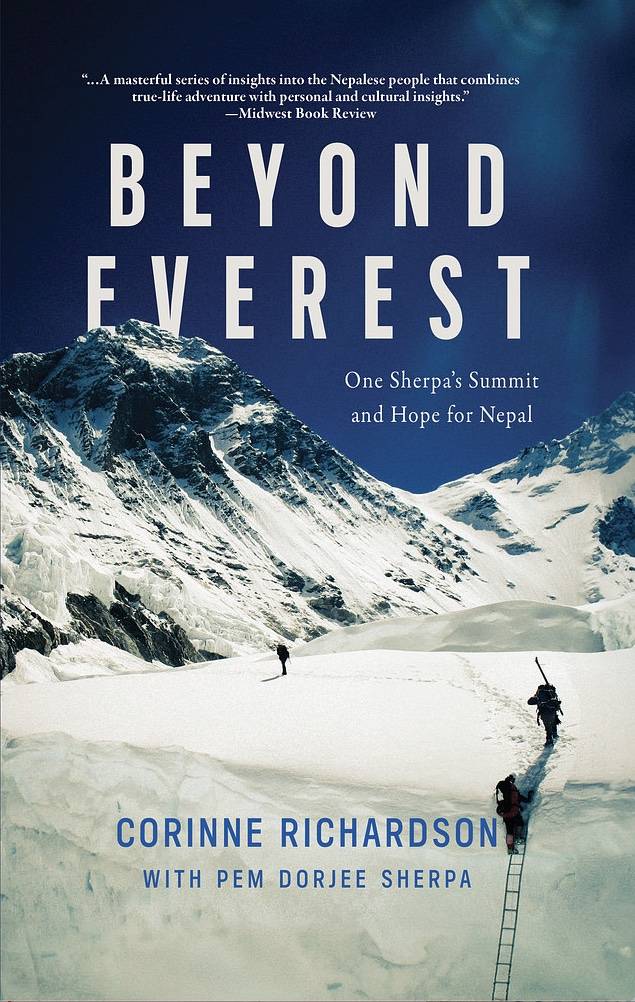
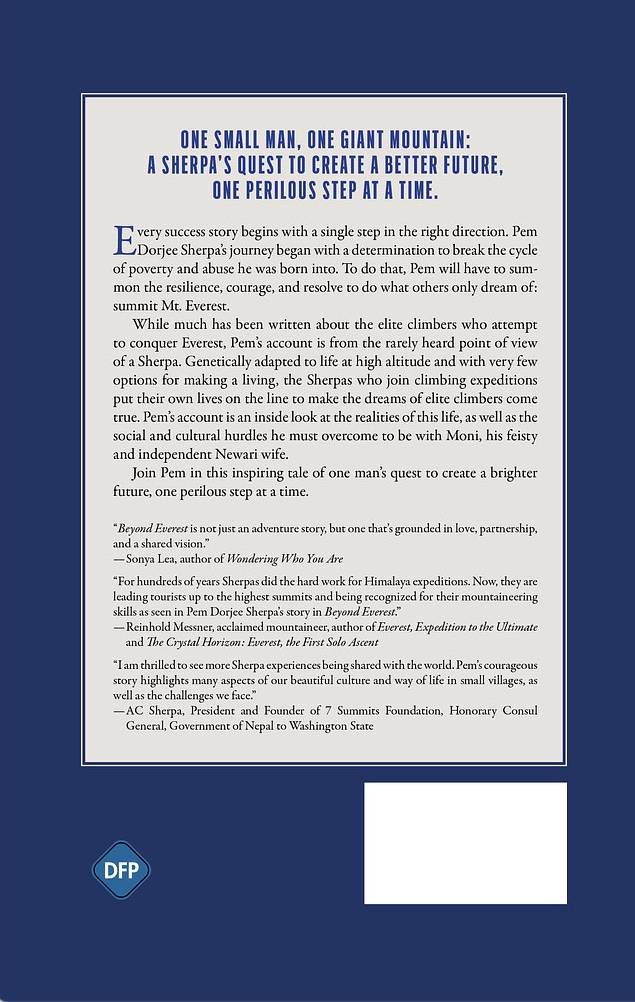
Beyond Everest
One Sherpa's Summit
and
Hope For Nepal
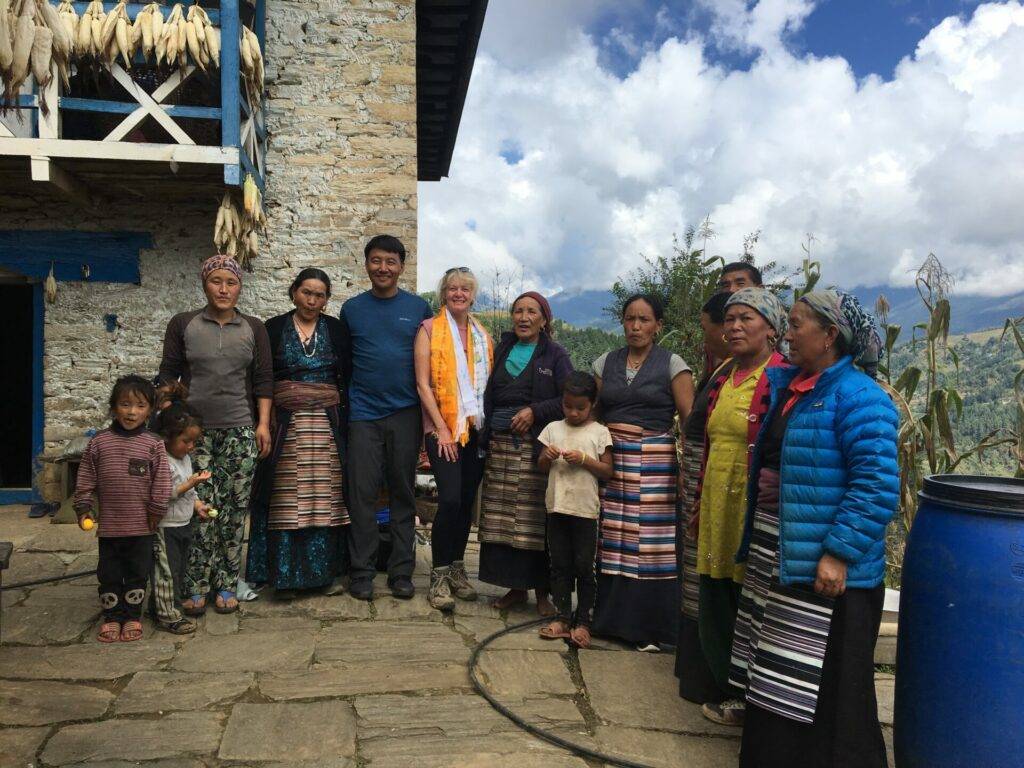
The author with Pem Dorjee Sherpa and his family in Chyangba Village Nepal
Beyond Everest: One Sherpa’s Summit and Hope for Nepal tells the unique and improbable story of a local Sherpa who escapes from the depths and struggles of poverty by summiting Everest. The records that he and his three-person Sherpa-Newari climbing team set at the world’s most spectacular and challenging peak (one involving a forbidden love story) paves the way for him to leave Nepal and establish a life of security and upward mobility that he’s never known before. It is a passionate, authentic story of a young Sherpa who defies near impossible odds of leaving behind a legacy of familial, generational, and cultural abuse, poverty, alcoholism, and child labor – bursting with stories of courage, resilience, and the tenacity required to hold onto a dream.
A Few Words About the Book
The seeds of this book emerged from an unexpected trip to Nepal, my first visit to this remarkable country, and grew over many returns to this stunning land and its people. How I got there was a bit circuitous. The backstory: in the winter of 2017, I was hired by an old, established New England liberal arts college, to “advance the frontiers of knowledge and understanding” by teaching English at their sister university, Shandong University of Science and Technology in Jinan, China. The job was a short-term position – just three months – a perfect fit under the circumstances. I was a mature, well-traveled ESL instructor with a couple of decades of teaching under my belt, both at Montana State University and abroad, and was single again with few ties keeping me home. Energized by a seven-month long training and teaching experience in Florence Italy, I was convinced that geographical distance and a good challenge would be sound post-divorce medicine.
In December 2016, I updated my vaccines, rented my home in Bozeman, and said my goodbyes to friends and anxious family in Maine. I was enjoying a farewell lunch, with my friend Mary Grace when she suddenly leaned across the table, grabbed my hand and blurted out, “Don’t go to China!” Her fierce hazel eyes meeting my soft, but blue-eyed gaze. Years ago, she had taken her thriving business to China to test the market with troubling results. She worried that the experience might crush my veritable, but fragile warrior spirit. She was leery of my excessively charismatic, celebrity, and sometimes bad-acting husband, and worried that I might be projecting false strength. Undeniably, over the eight-year marriage, I had lost some of my glitter and was rebuilding emotional muscles.
“It will be fine, it’s only a few months,” I assured her. I could do just about anything for that short period of time, I figured.
“Ok, but we need a code word in case you need to be rescued,” she said, in a stern parental way, though she is eight years younger. I immediately thought of the movie, “Taken,” where a CIA agent played by Liam Neeson sets out to find his teenage daughter and kill the villains who drugged, kidnapped, and auctioned her off the minute she landed in Paris on her first trip abroad. But I was a seasoned traveler, and besides, how bad could it be? “Baloney,” we decided, laughing and raising our wine glasses to friendship and adventure.
The job was a disaster. The first week in China, I developed the infamous “cough” often referred to as the “Beijing Cough” in guidebooks – a miserable dry cough caused by the unrelenting pollution across China, including Jinan, a city of 5.5 million that lies just south of Beijing. Jinan is a day’s drive from Wuhan to the south, now known as the Coronavirus epicenter. The cough kept me up most nights as well as my colleagues trying to sleep in adjoining thin-walled dorm rooms.
At the university, living conditions were unsafe and unhealthy – a roof that leaked onto the tile staircase landing outside our doors, toxic mold in the dorm rooms, beds that were essentially box springs covered with a thin pad. One weekend, colleagues and I took an eco-hike of the Great China Wall. Later that evening, while emailing photos of the Great Wall to friends and family at home, my computer shut down despite my deployment of two VPN’s and having encrypted my devices before leaving the US.
I quit a few weeks before the end of my contract when, an hour before class, the light bulb in my shower exploded with a sharp pop and crackling glass as it forcefully hit the shower tiles and my wet body before shattering to the floor. I spent an hour picking glass slivers from my scalp, shoulders, and feet, grateful that my eyes were spared. I missed class. When my explanation was met with a behavioral warning and a shrug, I emailed, “Baloney.”
“Get out of there!” Mary Grace emailed back. “Get to Kathmandu by May 3rd. My guide, Pem Sherpa will meet you at the airport.”
Mary Grace and Pem were working with a non-profit, the Tsering’s Fund, taking a group of underprivileged Nepali girls on a leadership program and finding sponsors in the US who would help fund their college education. Without schooling, the girls were slated for a life of child labor, early marriage, and risked being sold into the sex traffic trade.
Pem Sherpa greeted me at the Tribhuvan airport, his round Sherpa face smiling. He managed my overweight bags filled with textbooks and winter clothes and drove me to Hotel Tibet in Kathmandu where the true journey and evolution of this book unexpectedly began.
When I met Pem in Kathmandu, what I knew about him was that he had summited Everest twice, that he was raised in a remote, largely unheard-of village in Nepal in a family of subsistence farmers – a life that, at times, put his survival at risk. I knew that against tremendous odds, he had managed to become a U.S. citizen, partly by summiting Everest, and that he used this privilege to help his village and as many Nepali children he possibly could.
I spent a month in Nepal with Pem Sherpa and Mary Grace, working with the girls, teaching at the Shree Himalaya Primary School in Namche, and hiking the countryside with Pem. By the time I had left Nepal, I knew that Pem’s story had to be told, and I knew that I would be back. The following year, in 2018, Pem and I trekked from Lukla to the Khumbu Icefall. Along the route, he recalled some of the hardships he and his family endured in Chyangba, and his time as a young adult on the paths leading up to Everest’s summit. His parents worked the fields every day. They had very little. There were times when they didn’t have enough to eat or have shoes on their feet, or enough money to attend school. School was a four-hour walk from home. When Pem was twelve, he ran away from home to work at Everest and help support his family.
Pem is a humble man. He does not share his stories gratuitously or brag. Unlike most people, he would never volunteer that he has summited one of the most dangerous mountains in the world because drawing attention to himself makes him uncomfortable. If you ask him directly, he’ll tell you the story in its briefest form. His Buddhist traditions make him calm and trusting that everything will work out. As we talked, as I questioned, Pem’s astonishing stories of childhood, of summiting Mt Everest, and his experience immigrating to the United States took shape in powerful ways.
By the time I left the Khumbu Icefall, I knew this story had to be written. On the way to his village, as Pem and I walked past an old ramshackle teahouse in the middle of nowhere, he stopped and pulled up a picture from his phone. The photo was of a young girl who had been sold by relatives to a teahouse owner as a child laborer. When he told me the story, I knew then that I wanted to be the one to write the book. When I asked, he said yes, and thus began a beautiful collaboration that has spanned many years.
Mingmar
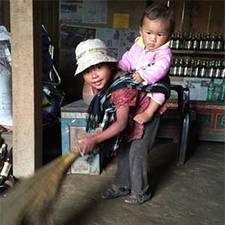
Inside the doorway of a run-down Nepali teahouse, in a warm beam of light, a young, round-cheeked girl hovers over a hard-packed dirt floor, her small hands deliberately wrapped around a grass broom, a chubby infant strapped to her back. As she sweeps, the baby sways and twists clumsily over her left hip, his tiny fingers clutching the white and black shawl wrapped around his bottom and knotted at her neck. The girl is dressed in a short-sleeved red patterned blouse that falls past her hips and over stained grey sweatpants that hang loosely and pile up on her toes. An oversized field hat with a pastel band running through the center covers her cropped, jet-black hair, the brim flopping down to her eyebrows. Behind her, the light shining off the rows of liquor bottles lining the shelves ignite her smooth, dark skin. She is bent over sweeping, her broom about mid-sweep, when she notices the Sherpa standing outside the doorway, his camera pointed at her. She stops mid-sweep, the grass broom paused and stretched out in front of her, the lopsided baby gripping her hips with his feet and stares directly into the camera. Her eyes are wide in surprise or curiosity, mouth open, her expression half-smiling, half bewildered, as if rooted in the servant world she has been sold into, yet aware of another – a child’s world – brighter, less capricious.
Her name is Mingmar. She is five years old. Sold to the teahouse owner by a relative and forgotten by her family, she is now a child laborer at a teahouse in Siganay Village, a remote mountain settlement with no roads or services and little connection to the outside world. The region, mostly unknown to tourists, is traversed on foot by a few locals, yak trains, and villagers headed to market with the rare exception of a trekking group passing through with a local guide showing the authentic, off the beaten path Nepal.
Pem and I stood just outside the door of the teahouse, staring at the sad, derelict building before us, my feet caked in mud from the wet, gumbo trail, as he told Mingmar’s story. I tried to imagine the life of this five-year old girl in the photo, calculating the impossible odds of her being discovered let alone rescued, her blotted out childhood restored in some slight or significant way.
The moment Pem laid eyes on Mingmar, he suspected that she was being exploited. His inquiries proved right. A few days later, Pem walked back up to the teahouse with an authority and a posse of strong Nepali men to confront the owner who admitted having paid 375 rupees for her. They walked Mingmar back to Kathmandu and placed her in an orphanage. Pem quickly sent a photo to Mary Grace in Big Sky, Montana with a note about Mingmar’s story. In a heartbeat, Mary Grace sponsored her in a school in Kathmandu.
